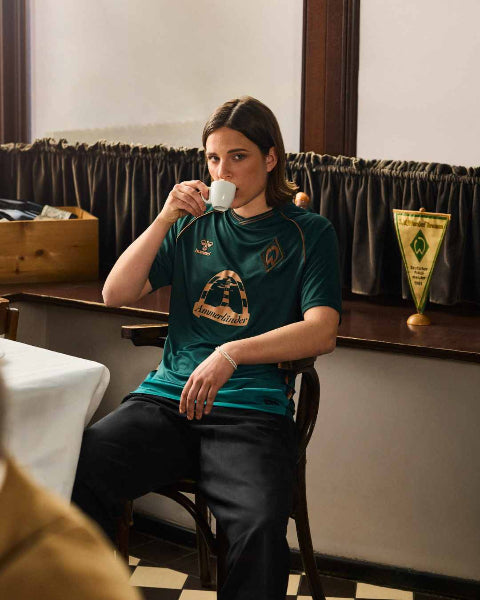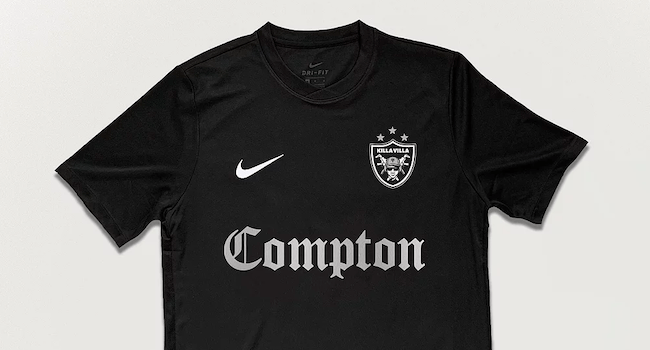Recently added
Vintage shirts
Concept kits
Legends
Are retro shirts worth it?
by Phil Delves March 04, 2022 5 min read

With prices rising across the industry and availability of vintage shirts being squeezed, a certain type of shirt has risen in prominence. The retro shirt, or retro remake, is priced affordably and allows fans and collectors to pick up designs which would otherwise be virtually unobtainable.
Today in Collectors Club I’ll be digging into retro remakes to see what sort of role they fill in a collection, if at all. Let’s jump right in.
What is a retro shirt?
We’ll start with a definition. For the purposes of this article I’ll use the term retro shirt or retro remake interchangeably to mean a shirt which has been created recently to mimic the aesthetic of a classic kit. Typically these shirts are sold for something in the region of £30, though they can be much cheaper or even priced around the same as a replica shirt (£60+).

The term “retro” is quite confusing, as strictly speaking by definition a “retro” shirt is any shirt from the past. It’s not the first time confusing wording has been used in the industry, the term “authentic” when designating player issue shirts implies replica shirts are fake, but for whatever reason we’ve landed at the point where a “retro shirt” usually means a “retro remake”.
Although most retro shirts are remakes of old shirts, there’s been a growing trend of people making ahistorical shirts which take inspiration from an old design before going in a different direction. A popular recent example would be the blackout England retro shirt which was doing the rounds last year. Based on the 1990 England third shirt, the blackout retro shirt was a shameless (though admittedly smart) attempt to cash in on the blackout trend that’s swept the industry, but fans lapped up the design nonetheless.
We’ll be focusing in on remakes of old designs for this Collectors Club, but some of the comments will apply to the more conceptual kits too.
Why are there no manufacturer logos on retro shirts?
Depending on who’s making them, retro shirts may or may not have a manufacturer logo. It can be quite a jarring sight to see a classic look devoid of an adidas trefoil or Nike swoosh, but for licencing reasons many retro shirts omit the brand mark.
Curiously you often see old patterns revived on ‘brandless’ shirts, even if they are clearly from a particular brand.
Many people assume that a shirt without a brand mark is a fake, but this is not always the case with retro shirts. Assuming the shirt comes from a licenced seller and/or the team in question there’s nothing fake about it, even if it can look a little bit lacking when compared to the real (but much more expensive) thing.
Who makes retro shirts?
Retro shirts usually come from one of two places. The first is directly from a team, either in conjunction with a third party (usually a company specialising in retro shirts, such as Score Draw or Copa) or from an in-house team at the club.

More and more clubs are releasing their own retro ranges each season, dipping into back catalogues as recently as the 00s (Liverpool are particularly ‘prolific’ in this area). For clubs who work with the same manufacturer as one they had in the past you can see retro shirts with the old manufacturer logo; a real boost in terms of the visual appeal of a kit. Arsenal have made something of a habit releasing these sorts of shirts, often pricing them quite high despite their remake nature.
Alternatively, there are a number of companies who specialise in retro shirts for various teams. I mentioned companies like Copa and Score Draw, and these are just two names in a competitive market. Pretty much any shirt is on the table here, from obscure teams to vintage designs that were last seen on the pitch several decades ago.
What are the best retro shirts?
I mentioned Arsenal previously, and despite the high price it’s impossible to ignore how well they’ve been doing in this particular department. Being able to bring back a classic 90s adidas design, be it the Bruised Banana or any number of adidas Equipment era looks, is a slam dunk for fans.
From a design perspective I’m a big fan of a brand I’ve mentioned a couple of times already, Copa. Copa Football shirts typically don’t have a manufacturer logo, but if you’re willing to overlook that they have a superb range of kit designs with many being shirts that would otherwise be impossible to find.
I’d have to mortgage my house to pick up a 1934 Real Betis home shirt, but Copa have a retro shirt of the same design available to scratch that particular itch. Copa shirts are at the more premium end of the retro market, typically coming in over £50, but again if it’s quality and not quantity you’re after they’re a good option.
Browse our collection of Real Betis shirts here.
Are retro shirts worth it?
Now for the all important question; are retro shirts worth it as a football shirt collector?
Say you’re trying to collect every shirt a particular team has worn in your history and you have a gap in your timeline which you’ve been unable to fill through the usual channels. Does a retro shirt provide a valid option in this case?
The short answer is no, at least strictly speaking. Retro shirts have their place (we’ll get onto that shortly), but they can never truly replace an original shirt. Once the initial buzz dies down, you’ll probably end up feeling the same need for an original, at least if you’re a completionist type who’s willing to spend years and years curating a rare collection.

Crucially in regards to collecting, even the most expensive retro shirts won’t gain value over time. Although retro shirts have a limited resale market, they’ll rarely if ever sell for more than their retail price on the second hand market. Some designs have been so popular that they’ve sold out (the blackout England retro mentioned previously, for example), but restocks are common across the board.
That’s not to say that retro shirts don’t have their place though, and if you’re a fan who wants to own a classic design at a reasonable price, or someone who wants to wear a vintage shirt without worrying about spilling a pint down it, retro shirts are a great option. You’re paying less upfront for a shirt which, for all intents and purposes, looks as good as the real thing.
Conclusion
Though I used to be somewhat sceptical of retro shirts, I’ve grown to appreciate their place in the industry. They will never replace original shirts, but they plug a gap which would otherwise be either impossible to fill or prohibitively expensive for the majority of people.
As a fan they can be a great way to show off your nostalgic pride for your club, and there’s no worries when it comes to getting pulls as you get stuck in on the terraces.
Phil Delves
As Head of Content, Phil is the creative playmaker of the team, covering every angle of football shirt news in our blogs and weekly Newsletter. Whether it's telling your fakes from your authentics, or deep dives into the newest football shirts designs, Phil will have all your football shirt content needs covered.
Sidebar
- Premier League football shirts
-
Other English clubs
- Birmingham City
- Blackburn Rovers
- Charlton Athletic
- Coventry City
- Derby County
- Hull City
- Ipswich Town
- Leicester City
- Middlesbrough
- Millwall
- Norwich City
- Portsmouth
- Preston North End
- Queens Park Rangers
- Sheffield United
- Sheffield Wednesday
- Southampton
- Stoke City
- Swansea City
- Watford
- West Bromwich Albion
- Scottish clubs
- Italian club shirts
- Spanish club shirts
- German club shirts
- International
- French club shirts
- Rest of the world
-
Legends
- Adriano
- Alessandro Del Piero
- Andrey Arshavin
- Alvaro Recoba
- Bobby Moore
- Bryan Robson
- Bukayo Saka
- Clarence Seedorf
- Cristian Vieri
- Cristiano Ronaldo
- David Beckham
- David James
- David Seaman
- David Ginola
- Dennis Wise
- Dennis Bergkamp
- Didier Drogba
- Dimitar Berbatov
- Diego Maradona
- Edgar Davids
- Eric Cantona
- Fernando Torres
- Freddie Ljungberg
- Gabriel Batistuta
- Gianluca Vialli
- Gianluigi Buffon
- Giovanni Elber
- Frank Lampard
- Francecso Totti
- Haaland
- Harry Kane
- Hidetoshi Nakata
- Ian Wright
- Jari Litmanen
- Ji Sung Park
- Juninho
- Jurgen Klinsmann
- Kaka
- Landon Donovan
- Lionel Messi
- Lothar Mattaus
- Luis Figo
- Mark Viduka
- Matt Le Tissier
- Mesut Özil
- Michael Owen
- Mikel Arteta
- Neymar
- Nicolas Anelka
- Nwankwo Kanu
- Paolo Di Canio
- Paolo Maldini
- Patrick Vieira
- Rafael Van der Vaart
- Raul
- Riquelme
- Rivaldo
- Robert Pires
- Roberto Baggio
- Robbie Fowler
- Ronaldo Nazario
- Ronaldinho
- Roy Keane
- Rudi Voller
- Ruud Gullit
- Ryan Giggs
- Santi Carzola
- Steve Bull
- Steven Gerrard
- Teddy Sheringham
- Thierry Henry
- Tony Adams
- Toto Schillaci
- Tugay
- Wayne Rooney
- Xabi Alonso
- Zinedine Zidane
- Zola
- Brands
Subscribe
Sign up to get the latest on sales, new releases and more …













